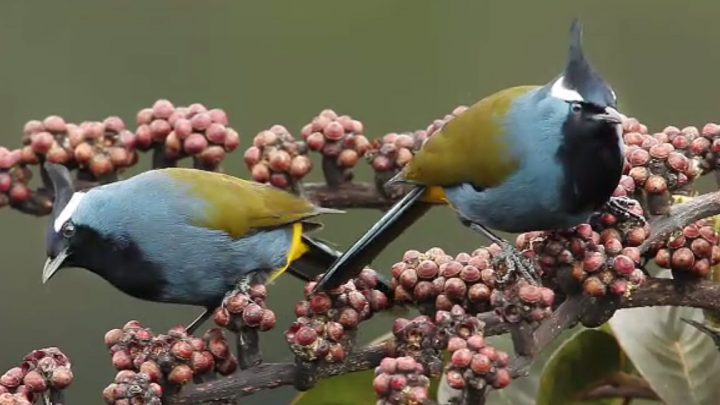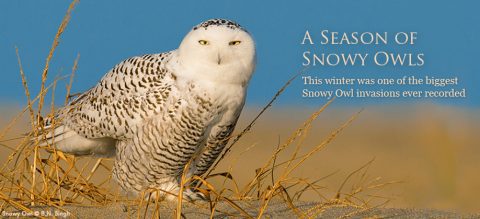50 Years Later, Climate Has Pushed New Guinea’s Birds Up and Off Mountains
By Hugh Powell
From the Spring 2014 issue of Living Bird magazine.
April 15, 2014
If ever a bird name sounded like it was made up by comedians, it’s the Crested Berrypecker. Perhaps it was named by exasperated European taxonomists trying to come to grips with the tropics. I imagine them starting on solid footing with thrushes and flycatchers, then stretching a bit when they came to babblers, bulbuls, and brush-turkeys. Eventually, after drongos, pittas, and pitohuis, somebody said, “Enough! Let’s just call it a berrypecker.”
Crested Berrypeckers do exist, just this side of make-believe, in the mossy, wooded mountaintops of New Guinea. The bird is spectacular: a vaguely jay-looking bird with a black crest, moody blue underparts, and brilliant yellow undertail coverts. The Macaulay Library has a video of one prying berries from a fruiting shrub. It patiently grips a berry in its bill, stopping and starting to get it in the right place, and tugs with its full body to pull it loose. Not once does the berry actually get pecked.
The noted scientist and author Jared Diamond saw something similar in 1965, when he encountered Crested Berrypeckers on a remote peak called Mt. Karimui. Sounding a bit puzzled, he wrote, “Paramythia montium… flies into a tree with a loud wing beat, hops around vigorously, plucks a few berries, and flies off again, leaving the tree full of uneaten berries.” Diamond also noted that he never saw the birds farther than 40 feet below the summit.
Today, nearly a half-century later, Crested Berrypeckers are one of four species on the verge of vanishing from Mt. Karimui. They and most of the mountain’s other species are retreating upward in the face of warming temperatures. That’s the finding of two young Cornell Lab of Ornithology scientists who retraced Diamond’s footsteps, publishing their results in the Proceedings of the National Academy of Sciences.
“The species that live at the mountaintop are going to run out of room,” said Ben Freeman, a Cornell Ph.D. student and author of the study. “And another 10 to 15 species will be put in very precarious positions as the climate warms.”
In all, Freeman and his coauthor (and wife) Alexandra Class Freeman, found 124 species on Karimui. They carefully recorded the upper and lower elevations at which they found each species and compared these with Diamond’s work. (Without Diamond’s meticulous studies, the Freemans’ work would not have been possible—inspiration for birders today to archive observations using eBird.)
Seventy percent of the species had moved their ranges upslope, by an average of 372 vertical feet. The average movement nearly exactly matched the average rise in temperatures. A second survey, retracing Diamond’s steps on another New Guinean mountain named Mt. Kanagioi, found the same pattern.
Scientists have seen these kinds of shifts in temperate places like North America, where birds like the Redbellied Woodpecker and Carolina Wren have shifted their ranges northward, and mammals called pikas have moved up mountainsides. Now, evidence is growing that it’s happening in the tropics, where there’s been less warming. Paradoxically it seems to be having more of an effect, because tropical species aren’t accustomed to big seasonal shifts in temperature and they tend to live out their entire lives in a narrow range of elevations.
The finding highlights the reach of climate change into areas that are otherwise largely untouched by humans. “This is one of the last places on earth where you could actually march from the bottom to the top of the mountain and be inside undisturbed forest the whole way,” Class Freeman said. “And still, there are effects of climate change happening here that are real.” And because mountains are shaped like pyramids, as soon as species start shifting upslope they start to be squeezed for habitat.
The Freemans saw only one Crested Berrypecker during their research—not even enough to estimate its elevational range. If temperatures rise another 1.8 degrees Fahrenheit—as is likely well before the end of the century—that improbable name will disappear from Mt. Karimui’s bird list. The birds themselves will persist on New Guinea’s taller mountains, but the writing is on the wall. Many more species—some more believable than a berrypecker, some more fantastical—cling to a similar fate in the mossy mountain forests of the world.

All About Birds
is a free resource
Available for everyone,
funded by donors like you
American Kestrel by Blair Dudeck / Macaulay Library



